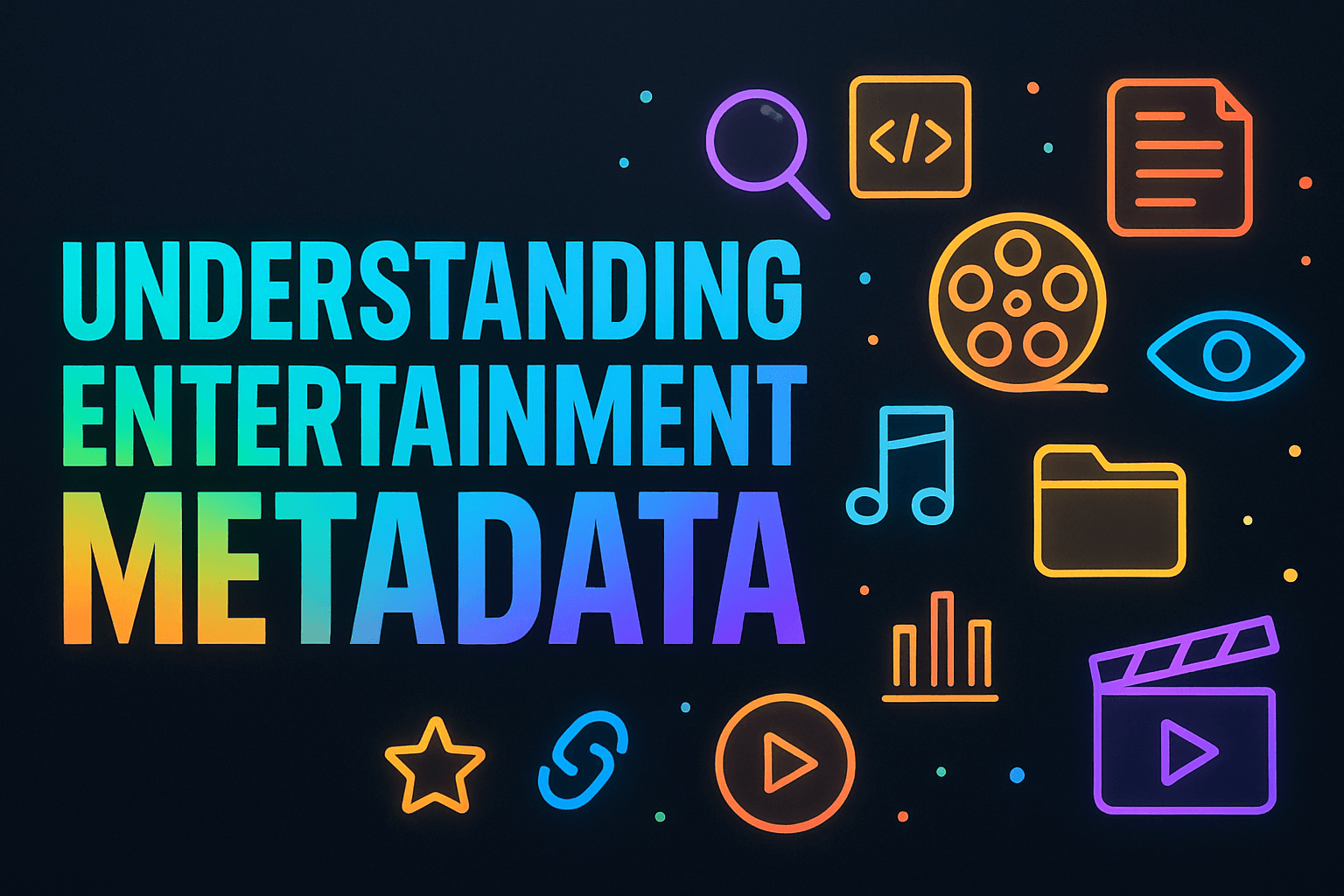Understanding Entertainment Metadata: A Strategic Guide to Linking Projects, Companies, and Executives

Introduction
In today’s data-saturated Media & Entertainment landscape, having access to information is not a competitive advantage; it’s the bare minimum. The real strategic value lies in the connections between data points.
For executives, producers, and financiers, understanding entertainment metadata is no longer a technical concern for the IT department, but a core competency for making smarter, faster, and more profitable decisions.
This guide moves beyond simple definitions to explain the strategic power of linked metadata—the invisible threads connecting projects, companies, and people—and how it provides a comprehensive, dynamic map of the entire global supply chain.
Table of content
- Beyond Title and Genre: What is Entertainment Metadata?
- The Core Challenge: Disconnected Data Leads to Missed Opportunities
- The Power of the Link: How Connected Metadata Drives Strategy
- Practical Applications: Turning Linked Metadata into Business Intelligence
- How Vitrina Builds the Connections in Entertainment Metadata
- Conclusion
- Frequently Asked Questions
Key Takeaways
| Core Challenge | The entertainment industry’s data is fragmented across siloed databases, making it impossible to see the critical relationships between projects, companies, and decision-makers. |
| Strategic Solution | Leveraging a platform with connected, or linked, metadata allows executives to navigate the industry ecosystem, revealing patterns, opportunities, and risks that are otherwise invisible. |
| Vitrina’s Role | Vitrina’s core technology is a relational database that actively maps these connections, providing a living, interactive view of the global M&E supply chain. |
Beyond Title and Genre: What is Entertainment Metadata?
In the simplest terms, metadata is “data about data.” In the M&E context, if a film is the “data,” its metadata includes its title, runtime, genre, and release year. For decades, this is where the industry’s understanding of metadata stopped. This is static metadata—a digital version of a library card catalog. It’s useful for basic identification but offers zero strategic insight.
The modern definition, and the focus of this guide, is relational metadata. Think of it not as a static label, but as a series of active connections. It’s not just the film’s title, but:
- The production companies behind it.
- The key executives who greenlit the project.
- The VFX, post-production, and localization vendors who worked on it.
- The sales agent who sold it and the distributors who bought it in each territory.
Relational metadata doesn’t just describe one thing; it describes the entire ecosystem around that one thing. It transforms a flat list of credits into a multi-dimensional, navigable map of professional relationships and commercial activity.
The Core Challenge: Disconnected Data Leads to Missed Opportunities
The primary obstacle to leveraging this relational power is data fragmentation. The entertainment industry’s information has historically been locked in disconnected silos.
An acquisitions executive might use one database to look up project details, a separate directory for company information, a personal address book for contacts, and trade publications for news.
This siloed approach creates immense inefficiencies and strategic blind spots:
- It’s Slow and Manual: Answering a complex question like, “Show me all the sci-fi projects currently in development from producers who have previously delivered on-budget films for a major streamer” requires weeks of manual research across multiple sources, if it can be done at all.
- It’s Incomplete: You can see what a company has produced, but not easily see the track record of the specific executives you are about to meet with. You can see a director’s filmography, but not the network of vendors they consistently hire.
- It Prevents Pattern Recognition: Disconnected data makes it impossible to spot emerging trends, such as a new financing company quietly backing a slate of successful indie films, or a boutique VFX house becoming the go-to vendor for a specific type of work.
These challenges of disconnected entertainment metadata mean that even the most experienced executives are often making high-stakes decisions with an incomplete picture of the market.
The Power of the Link: How Connected Metadata Drives Strategy
The strategic breakthrough comes when metadata is linked. A connected data platform allows you to navigate the M&E ecosystem seamlessly, pivoting from one data point to another to uncover deep insights. The value is not in the individual nodes (the project, the person) but in the connections between them.
From Project to Partner: Vetting a Production Company
Scenario: You discover an interesting independent film at a festival.
- Siloed Data: You know the film’s title and the name of the production company on the credits. Your research stops there.
- Linked Metadata: You click on the production company’s name. Instantly, you see their entire verified filmography, their key executives, their frequent collaborators (directors, writers), and the distributors who have acquired their previous films. In seconds, you have a complete due diligence package.
From Executive to Opportunity: Tracking Proven Talent
Scenario: You want to work with a specific producer known for delivering high-quality, commercially successful content.
- Siloed Data: You can look up their IMDb page to see their past work. You then have to manually scan the trades every day, hoping to see news about their next project.
- Linked Metadata: You “follow” the producer in your system. You automatically receive an alert the moment their name is attached to a new project that is still in the “in-development” stage, giving you a crucial early window to engage long before it becomes a competitive situation.
From Company to Trend: Mapping Market Movements
Scenario: You want to understand a competitor’s production strategy.
- Siloed Data: You can see a list of their recent releases.
- Linked Metadata: You can analyze their entire slate, including projects in production. You see they have partnered with the same two VFX vendors across five different projects. You identify a key co-financing partner they’ve used in a specific territory. You are no longer just seeing a list of films; you are mapping their entire strategic supply chain. A recent report from IBC.org emphasizes how such data-driven approaches are becoming central to media strategy.
Practical Applications: Turning Linked Metadata into Business Intelligence
When metadata is connected, it becomes more than just information; it becomes actionable business intelligence that drives tangible outcomes across different sectors of the industry.
- For Content Acquisition & Distribution: Use linked data to identify “hidden gem” projects by tracking up-and-coming producers or writers before they are widely known. Vet the commercial viability of a package by analyzing the past performance of the entire attached creative and financial team.
- For Production Service Vendors: Generate highly qualified leads by identifying projects that have just been greenlit and are entering pre-production. Target your business development efforts by finding producers who have a history of working with vendors in your specific specialization and region. This addresses one of the key pain points in the entertainment supply chain.
- For Co-Production & Financing: Discover and vet potential partners by analyzing which production companies have a history of successful international collaborations. Mitigate risk by reviewing a potential partner’s complete slate, financial relationships, and the track record of their key executives.
How Vitrina Builds the Connections in Entertainment Metadata
Vitrina was built on the fundamental principle that the connections are the most valuable asset. Our platform is not merely a collection of databases; it is a single, relational system designed from the ground up to map the entire global M&E supply chain.
Our technology systematically tracks millions of data points on film and TV projects, companies, and over 3 million executives and crew. But our core innovation is the proprietary process that creates and maintains the links between them.
When you view a project on Vitrina, you are seeing a living node connected to every company, every person, and every other project associated with it. This is how we build the connections in entertainment metadata.
We provide the dynamic, interactive, and comprehensive map that allows you to execute the advanced strategies outlined in this guide, turning a chaotic and opaque industry into a navigable and predictable landscape of opportunity.
Conclusion: From a List of Credits to a Strategic Map
Ultimately, the paradigm shift in the industry is from viewing data as a static record to using it as a dynamic, strategic tool. A list of credits is a historical document; a network of linked metadata is a predictive map that reveals where the industry is going next.
Understanding entertainment metadata in its relational context is the key to unlocking this predictive power. It allows executives to move beyond guesswork and hearsay, and instead base their most critical business decisions—from partner selection to content acquisition—on a comprehensive and interconnected view of the global market.
In an industry defined by relationships, the ability to see and navigate that network of connections is the ultimate competitive advantage.
Frequently Asked Questions
In the entertainment industry, metadata is all the data about a specific piece of content, like a film or TV show. Basic metadata includes the title, genre, and cast. Advanced, relational metadata includes a web of connected information, such as the production companies, financiers, VFX vendors, and all the key executives involved in the project.
The three common types are: 1) Descriptive metadata, which describes a resource for discovery (e.g., title, author, keywords). 2) Structural metadata, which indicates how compound objects are put together (e.g., how pages are ordered to form chapters). 3) Administrative metadata, which provides information to help manage a resource (e.g., rights management, creation date).
Metadata is critical for streaming services for content discovery and personalization. It powers the recommendation engines that suggest what to watch next based on genre, cast, director, and keywords. Good metadata improves the user experience, increases engagement, and reduces churn by making it easier for viewers to find content they will enjoy.
Data is used across the entire film industry lifecycle. In development, it’s used to analyze script potential and track talent. In financing, it helps vet partners and projects. For marketing and distribution, it informs release strategies and audience targeting. At a strategic level, connected data is used to map the supply chain and identify new business opportunities.

























